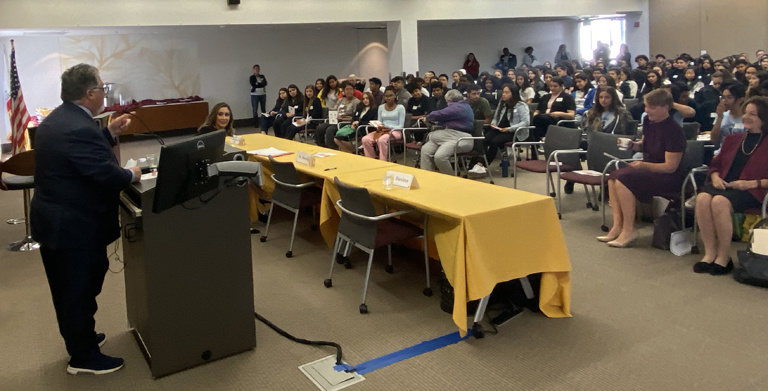
State Senator Anthony Portantino shares information with students attending the 11th Annual San Gabriel Valley HIV/AIDS Action Summit.
By Mary O’KEEFE
The 11th Annual San Gabriel Valley HIV/AIDS Action Summit was held Monday at USC Verdugo Hills Hospital. The purpose of the summit was to promote public health policy advocacy and to provide a global update on the disease.
Local schools, including those from Glendale, La Cañada and Crescenta Valley high schools, attended along with students from several other schools.
The summit was started and continues to be organized by State Senator Anthony Portantino.
“I had a personal connection to this issue,” Portantino said.
His cousin died from AIDS (acquired immunodeficiency syndrome). Throughout Portantino’s career in the legislation he has worked to educate and to streamline testing for HIV (human immunodeficiency virus).
“Healthcare professionals say the biggest and most important way of stopping the spread of HIV is to know your status,” Portantino said.
The summit is normally held at City of Hope in Duarte; however, due to construction issues, Portantino and his staff had to change summit locations. They contacted VHH, which was more than accommodating.
Portantino spoke of the importance of reaching out to a high school audience. Most of those in attendance had shown an interest in the medical field, like the students from Crescenta Valley High School’s Academy of Science and Medicine.
The purpose of the summit was to educate students on what HIV and AIDS are and also address the stigma that often comes with the diagnoses.
Portantino brought together health experts who focus on the field of HIV and AIDS. Many spoke of how past fears of the virus have stayed in our social consensus.
“Thirty years ago, when this epidemic was at its height, I was surrounded by death. Death everywhere,” said Dr. Alexandra Levine, a speaker at the event.
In the 1980s, when the affects of HIVand AIDS were felt throughout the United States, the virus seemed to be a death sentence for all who were infected. The fear of the disease came from the ferocious way it would attack the immune system in what seemed to be a short amount of time, and how it started was a mystery. Rumors of who was susceptible and how it was spread included that only homosexual men carried the disease and it could be spread in ways that have since been proven incorrect.
“It was a horrible time in the history of [the U.S.]. It was a horrible time in the history of medicine, and the social aspects of how we deal with one another,” Levine said.
The students in the room did not view AIDS the same way as older adults because, for the most part, the disease through treatment has been successfully controlled. The summit made students aware of the advancements by medical science in its prevention and treatment.
“I want to tell you what AIDS is and why you don’t want it, and what we are doing to try and prevent it,” Levine said.
She went on to say that only humans can get HIV and AIDS.
“No other animal can get HIV,” she said.
Levine explained that in the first few weeks of being infected about half of those who get HIV display flu-like symptoms that disappear in about two weeks. But the virus is with them. It is spread through the exchange of blood, semen and vaginal fluids.
“You can hug a person who is HIV,” she added.
Next week CVW will cover what students thought about the summit and how they plan to take that knowledge forward in their lives.
